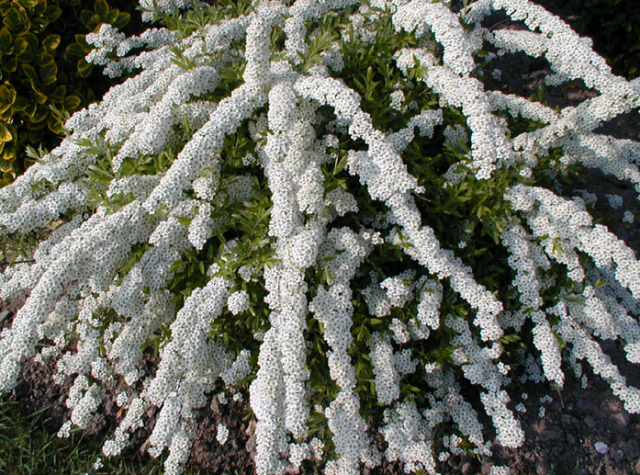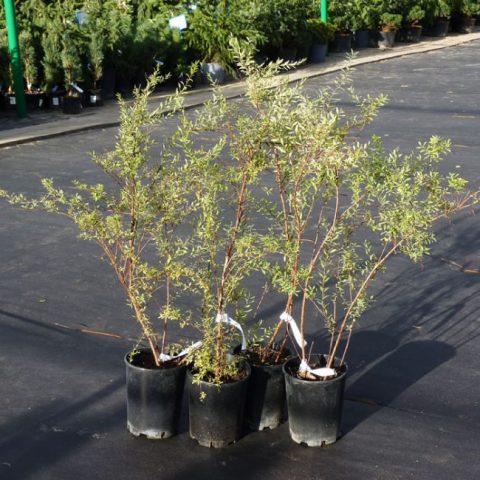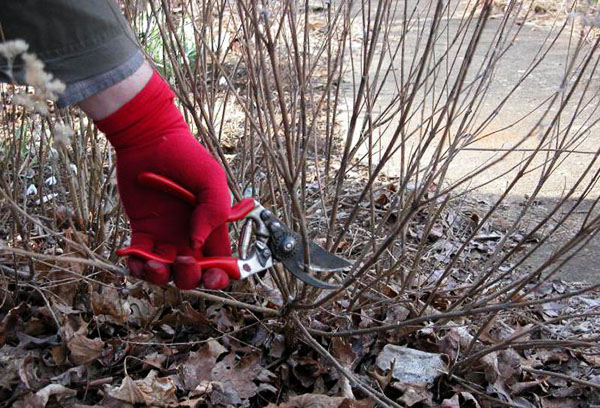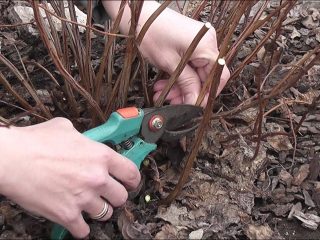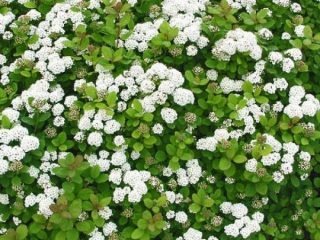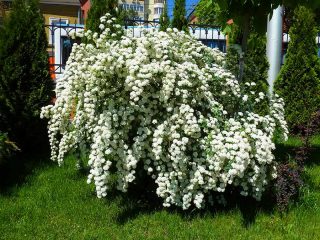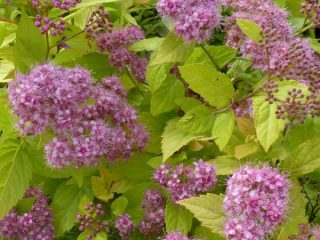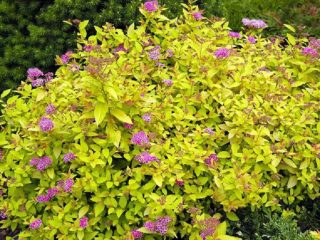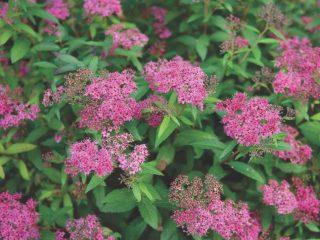Content
Beautifully flowering shrubs are used to decorate the garden plot. Spiraea Arguta (meadowsweet) is one of these plants. It has exquisite beauty if you provide proper care. The rules for growing shrubs, which are widely used by landscape designers, will be discussed further.
Description of Argut spirea
Spirea Arguta (spiraea arguta) is an ornamental shrub from the Rosaceae family. To create this hybrid, 2 species were used: Thunberg spirea and multifloral.
The shoots of an adult plant grow up to 2 m; the branches can spread up to 3 m in diameter. The leaf blades are narrow, lanceolate in shape. Sharp serrations are clearly visible on the dark green leaves. The branches of Argut spirea are thin and bend in the form of an arc. At the end of May and almost until the end of June, meadowsweet bushes are covered with white flowers. Long umbrella-type inflorescences are formed on shoots for 2 years.
Diameter of buds – 8 mm, petals – 5 pcs. Inside each flower there are a large number of stamens, due to which it becomes fluffy.When flowering begins, the leaves are practically invisible, and the branches droop under the weight of the inflorescences. And the whole space is filled with a honey aroma.
The development of the Argut spirea bush is slow; shoots grow by 10-20 cm per year, but regardless of this, the plant must be pruned.
Spiraea Arguta is widely used by landscape designers for single plantings and creating hedges. The shrub can be found not only in garden plots, but also in large parks. The plants look advantageous against the background of conifers.
Planting and caring for Argut spirea
Spirea seedlings can be planted in spring or autumn, before frosts begin. In order for the plant to take root well, choose a cool, preferably cloudy day.
Spiraea grows on any soil, but the shrub develops better if you add leaf or turf soil, peat, and sand to the hole when planting.
Meadowsweet is an unpretentious shrub that does not require special care. But when choosing a location, preference is given to openwork shade. Frost-resistant spirea can withstand temperatures down to -40 degrees.
Preparation of planting material
The survival rate and development of the shrub depend on the quality of planting material. You can use seedlings with open and closed root systems. If young bushes were grown in containers, then they are well watered before planting in order to pull out the seedling along with a lump of earth.
Plants with an open root system are specially prepared:
- For a day, soak in a solution of potassium permanganate or any composition that stimulates root development.
- If this part of the plant is too long, it is shortened with a sharp tool to 20-25 cm. It is important that the cut is even.
- The shoots also need to be shortened for all Argut spirea seedlings, leaving no more than 4-5 living buds for rooting to be successful.
Argut spirea seedlings (as in the photo below) can be grown independently, as the shrub reproduces well, or purchased from nurseries.
Landing rules
After choosing a site for planting single spirea bushes, in combination with other trees or hedges, you need to start preparing. The earth is carefully dug up and removed weeds and roots.
After this, dig a hole 2 times larger than the root system. For single plantings, 1-2 m are left between spirea bushes. To create a hedge, seedlings are planted at a distance of 70-80 cm.
Planting stages:
- The bottom of the dug hole is filled with 10-15 cm of drainage (large pebbles, broken bricks).
- The rest of the planting area is filled with fertile, loose soil.
- The earth is watered and allowed to go deeper.
- A small mound is made in the center of the pit, on which a spirea Argut seedling is placed.
- Carefully straighten the roots and cover them with soil so as not to deepen the root collar.
- Water the plant, then lightly tug the seedling if it is pulled down during planting.
- The root zone is sprinkled with mulch (peat or humus) to retain moisture.
Watering and fertilizing
Further care for spirea is no different from the measures that are necessary for deciduous shrubs.
After planting, the plants need systematic watering, but there is no need to bring the soil to the state of a swamp. Emerging weeds are removed, as they can cause diseases and pests.For fragile plants, such a neighborhood is dangerous.
If there is no rain, adult shrubs are watered once a week. Each bush will require 1.5 buckets of water. After watering, the soil in the root zone is loosened shallowly so that oxygen reaches the roots, and mulch is added.
Pruning Argut spirea
Spiraea sharp-toothed or Arguta must be pruned in order to properly form the crown of the bush. This procedure will benefit the meadowsweet, since the plant will then produce new powerful shoots, on which a large number of snow-white inflorescences will form next year.
In addition, pruning will give Arguta a decorative appearance, since you can create any shape for a deciduous shrub. You also need to cut out some of the young shoots, of which many grow over the summer. If you leave them, the bush will look sloppy, and heavily thickened plantings suffer from diseases and pests.
Spirea pruning is carried out for different purposes, it can be:
- sanitary;
- stimulating;
- formative;
- rejuvenating.
Sanitary pruning
Drying of meadowsweet shoots begins in the 2nd year. They should not be left on the bush, as spores of diseases and pests can overwinter on them. Branches that did not survive the frosty winter must also be pruned. The sanitary procedure is carried out early in the spring, before the buds open.
Damaged shoots are also trimmed during the growing season.
Stimulating haircut
This type of shrub pruning is carried out in early spring, when the spirea is 3-4 years old. When pruning, weak shoots and branches are removed, the spirea begins to branch better, which promotes abundant flowering. The bush itself will become healthier and more attractive.
Formative pruning
You can form the crown of a bush in spring or autumn.With this pruning you can get bushes with the desired crown shape.
Depending on the age and condition of the bush, shaping haircuts can be done in different ways: moderately or strongly.
Bush rejuvenation
Old bushes that have been growing on the site for more than 15 years need rejuvenation. So that spirea does not lose its attractiveness and continues to delight with snow-white clusters of fluffy flowers, it needs to be pruned. Haircuts are performed 14-21 days before frost, so that the wounds have time to heal and do not freeze in winter.
Preparing for winter
Adult plants do not need special shelter, since, according to the description, Arguta shoots can withstand frosts down to -40 degrees. But the roots are located close to the surface and need protection. In autumn, compost or humus is applied under the bushes in a layer of at least 30 cm.
Young meadowsweet bushes up to 4 years of age need to be specially prepared for wintering. The root zone is sprinkled with mulch. The branches, while there is no frost, are compressed and tied with twine. Burlap or any non-woven material is pulled over the top.
Protection from diseases and pests
Spiraea Arguta is a strong and robust plant that practically does not suffer from anything. But he can be bothered by aphids, spider mites, and caterpillars. Meadowsweet needs to be protected from these pests. For spraying you need to use special chemicals.
Reproduction
The Argut shrub ages over time; seedlings will be needed for new plantings. Gardeners should know the breeding characteristics of meadowsweet. You can get new plants by cuttings and layering.
Cuttings
Cuttings are cut in summer. The leaves are torn off at the bottom, and the stem is lightly scratched with pruning shears to stimulate root formation. Then they are buried at an angle to a depth of 2 cm. They are sprinkled with earth on top, watered well and covered with a plastic bottle. In the future you need to water. The seedlings are replanted next year.
By layering
In spring, young shoots of spirea are bent and pinned to the ground. The top is covered with soil. Regular watering is required during the summer. The following spring, the rooted cuttings are separated from the mother bush and transplanted to a permanent place.
Reviews of Argut spirea
Conclusion
With proper care, Arguta spirea will become an original decoration for your summer cottage. It can grow in one place for up to 25 years. Meadowsweet does not require special care, which is very popular with gardeners who do not have time for a daily trip to the dacha.
